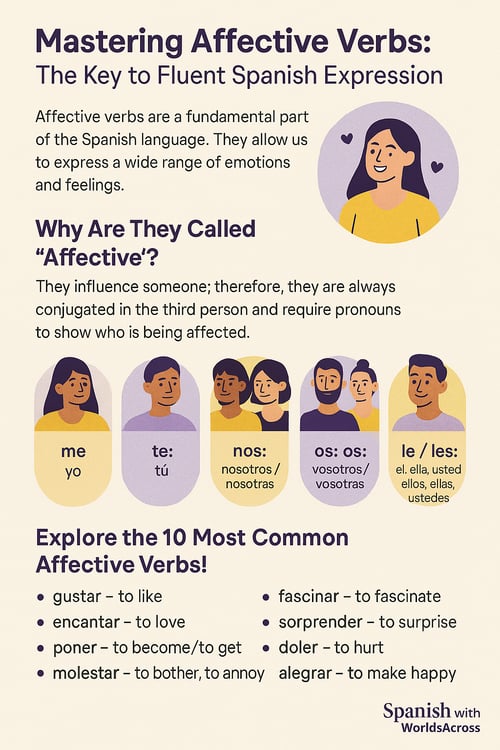Mastering Affective Verbs: The Key to Fluent Spanish Expression

Have you ever felt like words just don’t capture what you’re really feeling? Like saying "me gusta" when you actually love something, or "estoy triste" when what you're feeling is a whirlwind of emotions? It’s like trying to describe a sunset using only shades of gray! This is where affective verbs come in. These are your secret allies in the fascinating world of emotions in Spanish—the perfect tool to turn your plain “me gusta” into vibrant expressions that truly move others. Get ready to take a quantum leap in your communication and connect with people like never before!
Affective verbs are a fundamental part of the Spanish language. They are powerful tools that allow us to express a wide range of emotions and feelings. By understanding and using these verbs, we can enrich our interactions and connect more deeply with others. Whether we’re talking about our own emotions or describing someone else’s, affective verbs play a crucial role in our daily communication. So, let’s get ready to become true masters of expressing emotion in Spanish!
Why Are They Called “Affective”?
They’re called “affective” because they influence someone; that is, the person or thing causing the emotion becomes the subject of the sentence. That’s why these verbs are always conjugated in the third person, whether singular or plural. In addition, they require pronouns to show who is being affected. Here’s a guide to which pronoun corresponds to each subject:
- Me: yo (Example: "Me gusta el café.")
- Te: tú (Example: "Te vi ayer en la tienda.")
- Lo / La: él / ella / usted (Example: "Lo llamé esta mañana." / "La encontré en la oficina.")
- Nos: nosotros / nosotras (Example: "Nos invitaron a la fiesta.")
- Os: vosotros / vosotras (Example: "Os vi en el parque.")
- Los / Las: ellos / ellas / ustedes (Example: "Los vi en el cine." / "Las llamé ayer.")
Here are 5 affective verbs used with different pronouns:
- "Gustar": "A ella le gusta el chocolate" (She likes chocolate).
- "Encantar": "Me encanta bailar" (I love to dance).
- "Preocupar": "Nos preocupa que llegues tarde" (We’re worried you’ll be late).
- "Interesar": "A ellos les interesa la historia de tu país" (They are interested in the history of your country).
- "Doler": "A mí me duele el brazo después de hacer ejercicio" (My arm hurts after exercising).
Explore the 10 Most Common Affective Verbs!
There’s more to share! Below are some of the most common affective verbs and how you can use them in your daily conversations. (Some we’ve already mentioned.) Each verb has its own unique magic, so be sure to understand how to use it and what emotion it conveys.
- "Gustar" (to like)
Essential for expressing what you enjoy.
Example: "A ella le gusta el chocolate." - "Encantar" (to love)
Use this to talk about your passions. It expresses a deep love for something.
Example: "Nos encanta la música." - "Poner" (to become / to get)
Perfect for describing sudden emotional changes.
Example: "Te pusiste furioso cuando le dije la verdad." - "Molestar" (to bother / to annoy)
Expresses discomfort or irritation.
Example: "A Juan le molesta que la gente sea tan grosera." - "Preocupar" (to worry)
Ideal for speaking about concerns.
Example: "Me preocupa que te enfermes." - "Interesar" (to interest)
Great for showing curiosity or attraction to a topic.
Example: "A ella le interesa aprender nuevos idiomas." - "Fascinar" (to fascinate)
Use this to highlight something that really impresses you.
Example: "Me fascina cómo suena el español." - "Sorprender" (to surprise)
Expresses astonishment or surprise.
Example: "Te sorprende la amabilidad de la gente." - "Doler" (to hurt)
Ideal for expressing physical or emotional pain.
Example: "A ella le duele la cabeza cuando hay mucho ruido." - "Alegrar" (to make happy)
Perfect for expressing joy.
Example: "Nos alegra verte feliz."

Mastering these affective verbs won’t just enrich your vocabulary—it will also allow you to connect with others in a more meaningful way. When used correctly, your emotional expression in Spanish will become more fluid and authentic. So go ahead—practice, let yourself be swept up in the beauty of the language, and express your emotions freely in Spanish!




